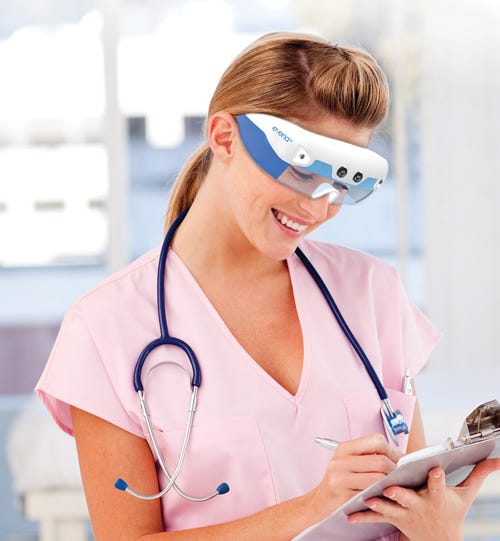Glasses That Let Nurses Get Under Your Skin
November 21, 2013
A Silicon Valley company called Evena Medical is betting that smart glasses will help nurses when it comes to the classic problem of finding a vein in an obese or elderly patient's arm.
A nurse can put on Evena's Eyes-On Glasses System and clearly see the veins underneath the skin. The recently unveiled glasses are but another example of "smart glasses" such as Google Glass potentially changing the way health practitioners perform their jobs.
The next question is whether the hospital systems the nurses work for will choose to buy when Los Altos, CA-based Evena's Eyes-On Glasses System starts shipping next year. (The glasses were demonstrated at this week's Medica conference in Dusseldorf, Germany.)
The company has been well aware of the issue and worked with a number of hospitals and clinics in the Kaiser Health system to make sure the glasses were in fact useful, says Evena CEO Frank Ball.
"We had to be sure the dog would eat the dog food," Ball says.
"It's a trap that many, many companies go down. They have engineers, and engineers love to build stuff. They think they can build it, and they will come. And then people don't come," says Ball, who has degrees in both engineering and marketing.
|
Besides the convenience of patients not having to be stuck with a needle multiple times by a nurse, the time saved might also make Evena Medical's Eyes-On Glasses System popular with hospital systems. |
Evena has already seen some success with its Evena Owl system, which sells for about $20,000 a piece and is run on a point of care cart. The glasses will sell for about $10,000 each.
Besides the convenience of patients not having to be stuck with a needle multiple times by a nurse, Ball also thinks there is an economic argument that could be persuasive for hospital systems.
Getting held up starting an IV can be a major waste of time for nurses. "As the [work] volume on the nurses goes up, they need to become more efficient," Ball says.
Investors, especially overseas distributors Evena is taking on, appear to agree. The 3-year-old company has raised more than $6 million and recently closed on a $2.9 million round, says Evena chief financial officer David Gruebele. It is now seeking to raise another $10 million to $15 million.
Evena's Eyes-On Glasses System is coming out at the same time that Google Glass is receiving quite a bit of attention in the medical device industry.
Philips Healthcare, for example, is touting Google Glass as a way to augment the information that its patient monitoring systems provide in operating rooms.
Ball, though, did not think Glass was the best fit for Evena because it is not a full glasses format. Evena already had a monacle device, called the Blade, that did not have a high-enough quality resolution to market well in clinical settings.
Then Epson came along with its Moverio glasses technology, and Ball and others at Evena saw the opportunity to take advantage of Epson's projectors, prisms, and mirrors--and to incorporate them in a frame that Evena designed.
"The Moverio was a huge breakthrough because it gives us a lightweight system to project it in front of the practitioner's eyes," Ball says.
Evena added multispectral lighting on each side to tease out where the blood hemoglobin is underneath the skin. (The hemoglobin absorbs light differently from surrounding skin and tissue.) Two custom-digital, hypersensitive cameras pick up the difference in light spectrum and then project back onto the see-through glasses, allowing a nurse to "see" the blood moving through veins underneath the skin.
A nurse is able to tap a button on the side of the Evena glasses to take a picture of what they are seeing, which can then be stored on the health system's electronic medical records system. Ball thinks the button was easier than taking pictures through eye blinks, since many nurses are used to more old-school interactions with devices.
Lauri Campbell, a spokeswoman for Evena, says the company is in the process of securing an addendum to a previous FDA approval.
The process of incorporating the Evena and Epson technologies took place over a matter of months, according to Ball.
"In five or six months, we went from seeing it to integrating it into the design," Ball says.
Chris Newmarker is senior editor of MPMN and Qmed. Follow him on Twitter at @newmarker and Google+.
About the Author(s)
You May Also Like



